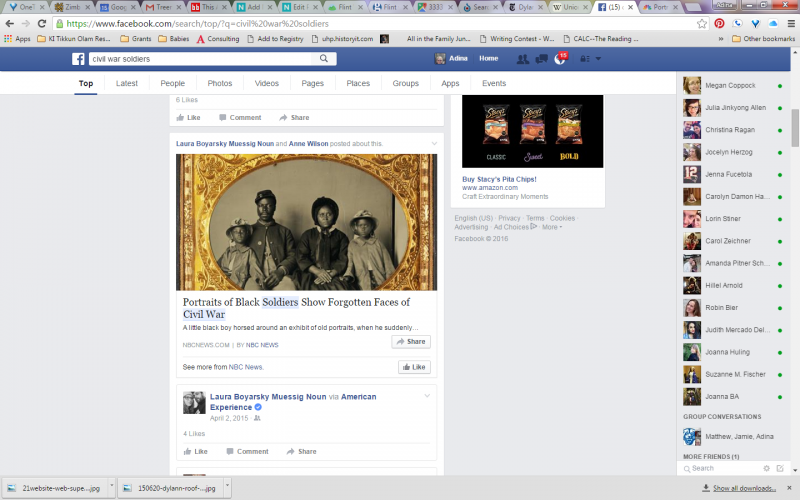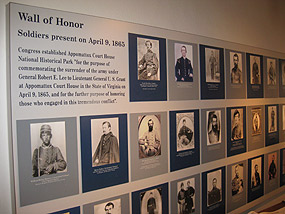Photography and Civil War memory (Part 2)
26 February 2016 – Kristen Treen

Article on Civil War soldiers on Facebook feed. Screenshot: Adina Langer
Unlike the Confederate flag, photographs enable the viewer to look the past in the eyes with a degree of sympathy, to interpret gesture, emotional expression, and the suggestive personal proffering of military possessions through a medium with which we now express ourselves on a daily basis. If photographs forge a human connection between the viewer and the past, the rigidity of the uniformed and anonymous soldier invites the making of certain assumptions about the political allegiances or the violently articulated beliefs of the stern faces into which we peer. Without narratives, the viewer might etch a political sentiment into these individuals, who become strange, affective symbols of a conflict-ridden past: a means by which we model or justify our own actions in human terms.
Where responses to photographs of Union and Confederate generals on social media sites often suggest a personal sense of connection or possession mingled with the veneration these leaders rightly or wrongly receive, the ordinary soldier ready to fight for his country or cause seems to create an emotional continuity between past and present that the modern viewer, living in an age of global terrorism and ongoing wars, cannot quite shake. If figures such as Abraham Lincoln, Robert E. Lee, or even Robert Gould Shaw become iconic to the extent that we forget the individual as a combination of national nostalgia and if values of statesmanship, valour, and heroism cloud our critical vision, then the unmediated photograph of the anonymous soldier, stripped of context, presents a danger more potent still. The danger is, of course, of empathy, and, of over-empathizing, with the deeds of the past in a way which contributes to the perpetuation of that past’s issues, its contentions, and the personal and political beliefs in the use of violence to settle its quarrels.

Wall of Honor at Appomatox Courthouse National Historical Park. Photo credit: National Park Service
In contrast to the inanimate symbolism of the flag, these photographs constitute examples of what Robert Penn Warren called America’s “felt history, lived in the national imagination” that “draws us as an oracle, darkly unriddled and portentous, of personal as well as national fate.” The feeling Penn Warren describes is surely, in part, nostalgia for the same values that Henry James believes should reside within the monumental form. Yet projects, including that of photographer Richard Barnes–who uses period techniques to capture Civil War reenactment on film, describe the lived approach to memorialization and the extent to which photographic form has shaped a nostalgic, corporeal monument to that moment.
How Americans choose to live that memory out evidently depends on a careful use of the photographic archive, a project which US national parks, including Appomattox Court House National Historical Park, have been confronting for a long time now. At Appomattox, a “Wall of Honor” encourages both an unraveling of the complicated narratives and political beliefs that led to what has become a charged symbolic moment in national history, and, at the same time, it acknowledges the pride in that past, and the connection to it, felt and cherished by many modern Americans. For those who contribute photographs to the walls of Appomattox, their feeling of the past is something to be shared and explored as part of a collective which recognises the voices of US Colored Troops alongside those of Confederate veterans and individuals who fought for the Union.
Unlike Dylann Roof’s solitary obsession with the determined faces of the past, the “Wall of Honor” works to confront and make visible the numerous, contentious legacies of the Civil War’s past that persist in and around the artifacts it left behind. While photographs, like values, are things that individuals hold dear, cling to, and find it almost impossible to give up, for those who see the photographs at Appomattox displayed together en masse, a “felt” past becomes less about one’s personal beliefs and more about learning how to peer, carefully and discerningly, into the windows of other people’s lives.
~ Kristen Treen is a Wolfson Scholarship PhD student at the University of Cambridge working on a thesis which examines the impact of the American Civil War’s material culture upon literary form and cultural formation from 1861 to the early twentieth century.
Editor’s note: This post continues our series addressing recent debates over Confederate memory and symbolism in the wake of the shooting of nine parishioners at Emanuel African Methodist Episcopal Church in downtown Charleston, South Carolina. Here is the opening post for the series. And here is part 1 of this post.



